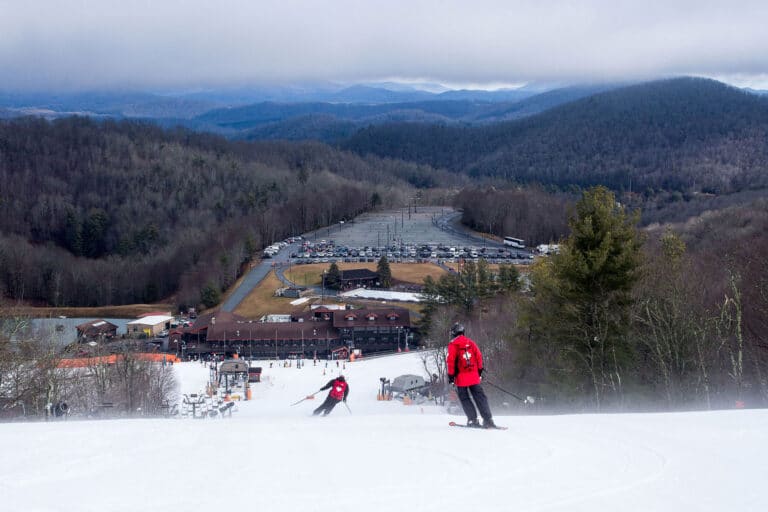Heather Anderson Sets a New Shenandoah FKT
On the first day of Heather Anderson’s Fastest Known Time (FKT) run on the Appalachian Trail (A.T.) through Shenandoah National Park in May, about 20 miles north of Rockfish Gap, she stopped briefly on the trail. She had just a fleeting glimpse, but she knew right away she was looking at a bobcat.
“It’s the first time I’ve seen one on the trail,” she says. “It was certainly a nice way to start the run.”
Firsts are rare for Anderson, who’s hiked thousands of miles in the wild. She’s finished the entire Appalachian, Pacific Crest, and Continental Divide trails three times. In 2018, she completed all three within one year, becoming the first woman to do so. She also holds the female self-supported FKT on the A.T., set in 2015, and the P.C.T., set in 2013.
“I’m infinitely curious about my abilities, and I also just enjoy movement in the outdoors,” says Anderson, who discovered her love of hiking while working a summer job at the Grand Canyon after her first year attending Anderson University in South Carolina.
An author of three books, professional speaker, and National Geographic Adventurer of the Year, Anderson knocked out two FKTs in close succession this past spring when she accomplished first the 250-mile Pennsylvania portion of the A.T. in 4 days, 14 hours, 9 minutes, and 9 seconds, and then just two weeks later, she clinched the time on the 110-mile Shenandoah portion of the A.T. in 1 day, 11 hours, 8 minutes, and 5 seconds.
“It’s something I’ve wanted to do for a while, and I felt like I was in good condition and in the mental space to do it,” she says. “It’s always cool to travel someplace you’ve been before but do it differently, and I’d always wanted to run the Shenandoah and see what it’s like.”
With her daypack, snacks, water, filter, and jacket, she hit the trail. “I’ve not run one since 2015 or 2016, so it was nice to see I could still do that, to execute a plan,” she says.
The bobcat wasn’t her only wildlife encounter on the trip: She also came around a corner while running at night, and her headlamp spotlighted a bear on the trail. It quickly ran off, likely scared by the light.
She spent 28 weeks over the winter and early spring preparing for the Pennsylvania project in her home state, running six days a week, 6 to 16 miles each day. She also added in yoga and strength training, for an average of three hours conditioning per day, but sometimes logging as many as six hours. She completed several multi-day backpacking trips as her Pennsylvania date approached. Then she recovered as much as possible before hitting the Virginia section, which she started on May 25.
“I’d been feeling burnt out, not feeling like pushing myself since 2018, and then last year I spent 10 weeks in Scotland backpacking,” she says. “It was a heavy pack; I was mostly camping, and it was very challenging. I realized I was feeling like my old self, that I could cope with a heavy pack, that I was recovered from my mental and physical burnout.”
So last fall she selected her missions, and she pulled them off despite suffering from heat sickness on her second day in Shenandoah. “I thought it could happen because it’s hotter than Pennsylvania, and I’m not acclimated to it,” she says, describing how she pushed through the nausea. “I got to a spring and drank a lot of water, and I was able to eat again after that.”
When she’s tackling a trail, Anderson says she’s usually focused on the task at hand, taking in the sights and sounds around her. “I feel like my experiences are reminders of the real world that we all tend to be more or less disconnected from in our daily lives,” she says. “I am happiest when I’m connected to and immersed in that real world and hope that by sharing my experiences that others will choose to seek that experience out for themselves as well.”
Anderson, who was 41 at the time of her FKTs this year, offers training and mentoring to hikers who want to attempt a goal of their own. Her books—”Thirst: 2600 Miles To Home”; “Mud, Rocks, Blazes: Letting Go On The Appalachian Trail” and “Adventure Ready”—also explain what she’s learned from her expeditions that she attempts to share with others.
“It’s important to always go for something bigger than you think you can do, not to put unnecessary limits on yourself, or to try to keep us safe, within our comfort zones,” she says. “[When you push beyond those zones], you experience beautiful things and have a lot of growth.”
Cover photo: Photo courtesy of Heather Anderson








